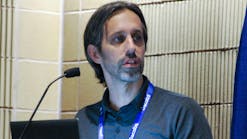Paul Steele with Jacobs Engineering Group told attendees of a Tuesday WEFTEC session how his company helped a Chattanooga, Tenn., water utility identify $8.6 million in annual savings and revenue by improving its water and solids waste treatment streams.
“So that's not normal in this industry,” said Steele, who is the Americas east regional market solutions leader - water resource recovery for Jacobs.
Jacobs offers environmental solutions at each phase of the project life cycle, from planning and permitting design, construction and operation. When Jacobs performed an energy audit for the City of Chattanooga’s Moccasin Bend Water Treatment Facility in 2022, the issues the municipality faced were clear.
The facility was using a high purity oxygen (HPO) process for sludge treatment, something that Steele said is both an antiquated and energy intensive process. That fact was borne out in the audit, which found that the facility’s HPO process alone made up 21 percent of its total energy costs.
Another problem was the biogas produced by the treatment facility. Steel said the city purchased a scrubber in the 1980s, but that equipment never worked properly, so after two years Moccasin Bend just started flaring all the biogas it produced.
The facility also faced issues with solids stabilization. Because of inefficient systems, Moccasin Bend was only digesting about 10 percent of its solids from lime stabilization. This led to the utility overspending for cake hauling services. And according to Steele, the facility’s lime stabilization methods created foul smelling solids, which triggered complaints from the community.
Moccasin Bend also had an unstable nitrification issue that led to the plant having to use massive amounts of hypochlorite.
“I don't know if any of you have seen a facility that pays $5 million for chlorine (in a year), but this is a huge cost,” Steele said.
So, the Jacobs team provided some suggestions. Chief among them was replacing the outdated HPO with a membrane aerated biofilm reactor, or MABR
According to Steele, the technology works through diffusion. Gases are pulled through the membrane by lower dissolved oxygen (DO) concentrations on the biofilm side. Lower DO is caused by wastewater strength, and low strength wastewater reduces the pull by allowing higher DO concentrations at the membrane surface.
Steele said an MABR allows for nitrification without reactor volume expansion, and an MABR greatly reduces nitrate formation, which reduces the need for chlorine.
Another major change Jacobs suggested for Moccasin Bend was converting its solids train from lime stabilization to one that utilizes thermal hydrolysis (THP) and mesophilic anaerobic digestion (MAD).
This change would allow for the facility to eliminate lime stabilization and digest 100 percent of sludge loads with its existing digesters. It would also enable the biogas created at the plant to be upgraded to renewable natural gas.
Jacobs also suggested that the facility incorporate fine bubble aeration, which would further reduce energy costs.
The major changes suggested from Jacobs came with a $136 million price. But according to Steele, Jacobs estimated that the optimized operation at Moccasin Bend could create the following savings:
- Reducing biosolids from 64.8 tons per day to 32.4.
- Increasing biogas from 82 standard cubic feet per minute to 785.
- Reducing hypochlorite demand by $2.2 million annually.
- $900,000 in power savings every year.
- Reducing cake hauling costs by $1.5 million a year.
That’s on top of the $4 million per year in estimated biogas sales. Steele said the savings and revenue from the changes cover the costs of the investment in about 15 years.
“So, we have a nine-figure project that can pay for itself,” he said.
